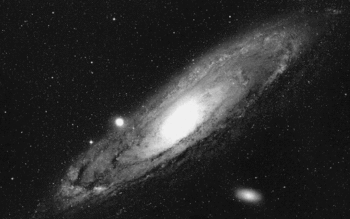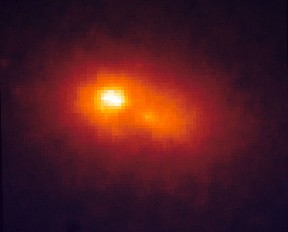Andromeda Galaxy
The Andromeda Galaxy (Messier list object M31[1]) is a spiral galaxy approximately 2.5 million light years away from Earth. The furthest galaxy, by comparison, is about 13,000,000,000 (thirteen billion) light years away.[2]
| M31 | |
|---|---|
| Observation data | |
| Constellation | Andromeda |
| Right ascension | 00h42.7m |
| Declination | +41o16' |
| Distance | 2.5-2.9 million light years |
| Type | Spiral Galaxy |
| Apparent dimensions | 178.63 arc minutes |
| Diameter in ly | 250,000 |
| Apparent magnitude | 3.4 |
| Other designations | NGC 224, M 31, Chained Maiden |
The largest of our nearest galactic neighbors, its disk is about 260,000 light-years in diameter. The disc of the Milky Way galaxy, our own, is considerably smaller, approximately 100,000 light years across.[3]

The galaxy is in the constellation of Andromeda, named for a princess in Greek mythology; the name means "to think," "to attend to" or "be mindful of". The myth of Andromeda is a story of a princess chained to a rock as a sacrifice to a monster. Ultimately she was saved, but the story also endows the galaxy with the appellation "The Chained Maiden".
History
Although the galaxy was known to Al-Sufi in Isfahan around AD 905, Charles Messier was unaware of earlier Persian records and attributed its discovery to Simon Marius, who gave a telescopic description of Andromeda in 1612.
In 1654, Giovanni Batista Hodierna discovered Andromeda without knowledge of what others had recorded long before he saw the galaxy. In 1716, Edmond Halley credited the discovery of what he then labelled a "nebula" to the French astronomer Bullialdus (Ismail Bouillaud), who made his observations of Andromeda in 1661. For his part Bullialdus attributed its discovery to an anonymous astronomer 150 years prior (sometime in the early1500s).[4]
Characteristics
Andromeda (M31) has a radial or heliocentric velocity of about -300 +/- 4 km/s.[5] The Milky Way and Andromeda are approaching each other at about 100 km/sec and may collide in about 3 billion years.[4][6]
Size
Visible to the unaided eye, Andromeda appears several degrees in diameter and contains approximately 1,000,000,000,000 stars (one trillion). The Milky Way by comparison contains about 200,000,000 (two hundred billion). Conversely, new measurements employing infrared technology indicate that Andromeda's energy output is about that of 4,000,000,000 (four billion) suns. Although Andromeda has a greater number of suns, the most recent measurements concur with earlier estimates and show that its mass is smaller. The mass of Andromeda is now calculated to be 1.23 trillion solar masses, significantly less than the 1.9 trillion for the Milky Way.[7][4][8][9]
Age, composition and structure
Spiral galaxies are organized into three regions: a central bulge, a flattened disk outside the bulge, and the outermost region, the halo. Spiral galaxies are classified in a range of shapes from elliptical to dwarf irregular classes in the Hubble sequence. Bulges and halos are spheroidal in shape. Bulges have a greater central density, thinning quickly, they are more sharply truncated at the outer edges, and have a higher abundance of heavy elements (metallicity). Typically, discs form stars at a steady rate over their lifetime. By contrast, the current data suggests that halo stars are formed early in the history of the galaxy or were acquired when satellite galaxies are absorbed when they collide.[10]
Larger spiral galaxies such as Andromeda may have been formed by the merger of other less massive galaxies and their halos composed of the accumulated debris of these smaller galaxies.[11]
Galactic center
Double nucleus
Andromeda apparently has a double nucleus of two star clusters about 5 light years in distance from each other. There are two theories for this phenomenon: the entire nucleus is either partially obscured by dust clouds making it appear to be in two separate sections, or the galaxy previously engulfed another smaller galaxy about one billion years ago and its core remains as a relic of the collision separate from the original Andromeda core. The first indication of a double core was made in 1986 by Jean-Luc Nieto (Pic du Midi Observatory in France). Nieto noticed that there was a bright nucleus separated by a few light years from the exact center of the galaxy's central bulge. The Hubble Space Telescope later revealed that the dimmer of the two light peaks is the true nucleus and that earlier ground-based observations had in fact identified the wrong peak as the nucleus.[12][13]
Black hole
In 1988, data taken by John Ormandy (University of Hawaii), Alan Dressler (Observatories of Carnegie Institution, Washington) and Douglas O. Richstone (University of Michigan) showed a sudden increase in orbital velocities of stars at the center of M31. Current theories postulate a black hole of about 10 million times the mass of our sun. If in fact there is a black hole in Andromeda, this would seem to indicate that the cannibalised galaxy's core would have been destroyed within a few hundred thousand years. A possible soution would be if the smaller galaxy had its own black hole that would have kept it from being dissipated.[13]
Additional evidence for the existence of a black hole at the center of Andromeda is the presence of a disk of hot, young stars around the center of the galaxy, which emit a blue light. Thought to be a single star when first seen in 1995 by Ivan King (University of Washington) and his colleagues with the Hubble telescope, in 1998, Tod Lauer and Sandra Faber (University of California at Santa Cruz) used Hubble again and their observations indicated that the blue light was a cluster of blue stars.
At present, it is unknown how the pancake-shaped disk of stars could form so close to a giant black hole without being torn apart. Tidal forces of the black hole make it difficult for gas and dust to collapse and form stars. On the other hand, the discovery of the disk of stars, provides very strong evidence for the existence of the monster black hole and rule out all alternative theories for the dark mass in Andromeda's core.
The disc is only about one light-year in diameter and is composed of about 400 stars that formed in a burst of activity about 200 million years ago. These stars are rapidly orbiting the black hole just as planets in our solar system revolve around the Sun. Calculations for the stars' speeds are derived by measuring how much their light waves are stretched (red shift) and compressed (blue shift) as they travel around the black hole. Under the black hole's gravitational grip, the stars are orbiting at 2.2 million miles an hour (3.6 million kilometers an hour, or 1,000 kilometers a second). (By comparison, at that speed it would take them 40 seconds to circle the Earth and six minutes to arrive at the Moon.) The fastest stars complete their orbit of the black hole in 100 years.[14][15]
Spiral arms
Halo
At present, there are about 300,000 stars that have been distinguished in the halo, a spherical cloud of stars around Andromeda. Using a photo taken with the Advanced Camera for Surveys aboard NASA's Hubble Space Telescope capturing both faint dwarf stars and bright giant stars, estimates of the age of the halo population are made by analyzing its distribution of color and brightness.
In 2003 astronomers were surprised to learn that approximately one-third of the stars in Andromeda's halo formed within the last 6 to 8 billion years. The entire star population in the halo span a range of 6 to 13 billion years old, much wider than that of the stars in the Milky Way halo, where stars range from about 11- to 13-billion-year-old. One theory is that the presence of younger stars in the Andromeda halo is the result of mergers with smaller galaxies which may have been composed of younger stars.
The younger stars in Andromeda's halo recently discovered are richer in heavier elements than the stars in our Milky Way's halo and in most of the small dwarf galaxies that surround the Milky Way. The level of chemical content in these younger stars is characteristic of relatively massive galaxies, containing at least a billion stars. There are three possible explanations for the age and chemical content of these M31 halo stars: (1) Multiple collisions destroyed the M31 disc formed more recently and scattered many of Andromeda's stars into the halo; (2) One single collision with another massive galaxy dispersed its stars and some of Andromeda's disk stars into the halo; and/or (3) Many new and therefore younger stars formed during the collision itself.[16][17]
M31 globular cluster system
Andromeda has possibly as many as 500 accompanying extragalactic clusters of stars. The two bright points in the photo above, Andromeda Galaxy with two of its orbiting globular clusters, are but two of the brightest.[18] The M32 (NGC 221) is at the lower center of the photo, and NGC 205 (sometimes designated M110) is to the upper left.[19]
G1 (Mayall II)
Composed of about 300,000 old stars, G1 is a dwarf elliptical in orbit around the Andromeda galaxy at about 170,000 light-years from Andromeda's nucleus. The brightest globular cluster in the Local Group of galaxies, G1 is about 2.9 million light years from Earth. With a visual magnitude of 13.7. G1 can be seen with larger amateur telescopes.[20][21]
G1 may have a rather large black hole at its centre, estimated to be about 20,000 solar masses. G1 itself has an estimated ten million solar masses, 10 million times that of our Earth's sun.[22]
References
- ↑ [1] NASA
- ↑ Hubble & Keck Teams Find Farthest Known Galaxy in Universe Goddard Space Flight Center, NASA
- ↑ Andromeda NASA
- ↑ 4.0 4.1 4.2 Messier Object 31 Frommert, Hartmut & Kronberg, Christine (2003) Students for Exploration and Development of Space
- ↑ Andromeda NASA IPAC Extragalactic Database
- ↑ Planetary core in colliding galaxies Horack, J. (2004) Science at NASA
- ↑ The Mass of Andromeda Galaxy Smithsonian/NASA ADS Astronomy Abstract Service
- ↑ Andromeda Adrift in Sea of Dust in New NASA Image NASA
- ↑ M31 (the Andromeda Galaxy) Goddard Space Flight Center, NASA
- ↑ Discovery of an extended halo of stars in the Andromeda spiral galaxy Guhathakurta, Puragra, Ostheimer, James C., Gilbert, Karoline M., Rich, R. Michael, Majewski, Steven R., Kalirai, Jasonjot S., Reitzel, David B. & Patterson, Richard J. (2005) Cornell University Library
- ↑ The Once and Future Andromeda Stream Mori, Masao & Rich R. Michael (2006). Submitted to Astrophysical Journal Letters. Cornell University Library arXiv.orf
- ↑ Double Nucleus of the Andromeda Galaxy, M31 Hubble Spies Extragalactic Globular Cluster G1 in the Andromeda Galaxy M31 SEDS
- ↑ 13.0 13.1 Hubble Space Telescope Finds a Double Nucleus in the Andromeda Galaxy Villard, R., Lauer, T. & Faber, S. (1993) Hubble Site News Center, NASA
- ↑ Hubble Finds Mysterious Disk of Blue Stars Around Black Hole (2005) Hubble Site News Center
- ↑ The Andromeda Drain (2000) The Chandra X-ray Observatory has spied a peculiar black hole at the center of the Andromeda galaxy. NASA. Marshall Space Flight Center
- ↑ Young and Old Stars Found in Andromeda's Halo Deepest View of Space Yields Young Stars in Andromeda Halo Hubble Site News Center, NASA
- ↑ [2] HST photo collection, NASA
- ↑ scanned GIF [3] or PDF Extragalactic globular clusters. II. The M31 globular cluster system Huchra, J. P., Brodie, J. P. & Kent, S.M., (1991) Astrophysical Journal 370: 495-504 April 1
- ↑ The Andromeda Galaxy Bill Schoening, Vanessa Harvey/REU program/NOAO/AURA/NSF National Optical Astronomy Observatory
- ↑ Hubble Spies Extragalactic Globular Cluster G1 in the Andromeda Galaxy M31 Frommert, Hartmut & Kronberg, Christine (1999) SEDS
- ↑ MAYALL II (2007) NASA/IPAC EXTRAGALACTIC DATABASE
- ↑ Hubble Discovers Black Holes in Unexpected Places (2002) Hubble Site News Center


